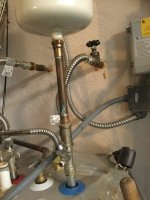Jadnashua
Retired Defense Industry Engineer xxx
And, it also says that higher pressures than 80psi are dangerous. The WH is typically tested to 300psi, but the safety relief valve is set to 150psi to provide a safety margin.
Pre-charge is used to essentially put the bladder in its neutral position when 'normal' pressure is in the lines. It also allows the maximum safe volume when the water is heated.
Bottom line, install per code which also means following the device's installation instructions. If you look at the typical installation diagrams in any of them, they do not show a valve between the ET and the WH.
Pre-charge is used to essentially put the bladder in its neutral position when 'normal' pressure is in the lines. It also allows the maximum safe volume when the water is heated.
Bottom line, install per code which also means following the device's installation instructions. If you look at the typical installation diagrams in any of them, they do not show a valve between the ET and the WH.

